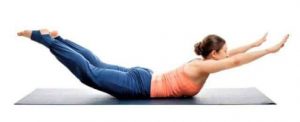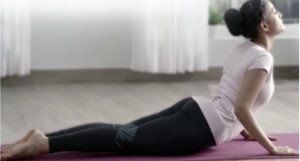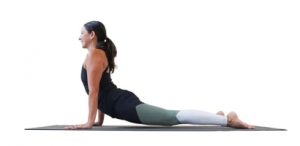Do you stand or walk like a limbo rocker? If yes, you may have “Sway Back”
Apart from slouching, sway back is another common bad posture that leads to back pain. The sway back posture also known as the “lazy posture”, is almost the opposite of slouching forward and is identified by shoulders and chest leaning backwards, with hips turned in and pelvis and chin thrust forward.
People who adopt this posture often find themselves needing additional external support, such as a wall or other grounded objects to lean against. The sway back posture is almost the antithesis to the flat back posture.
This posture represents a faulty posture that differs from the good one by the following:
[1] Anterior pelvic shift
[2]Thoracic kyphosis extended to the upper part of the lumbar spine (longer thoracic kyphosis is observed)
[3] Shorter lumbar lordosis
[4] Normal or slightly decreased anterior pelvic tilt
This could arise from faulty habitual postures and weakened muscles. eg Over-active/tight hamstrings, ligament laxity, incorrect strategy for good posture, bad habits such as sleeping on your stomach and poor posture in sitting
INDICATIONS
[a] Lengthening of:
- Erector spinae in the upper thoracic and upper lumbar part
- Scapulaestabilisers (serratus anterior, lower and middle part of trapezius and rhomboid muscles)
- Abdominal muscles (their lower part)
- One-joint (iliacus, psoas) and two-joint hip flexors (rectus femoris, tensor fascia latae)
[b] Shortening of muscles below that all show hyperactivity:
- Suboccipital, sternocleidomastoid,scalene muscles
- Chest muscles—pectoralismajor and minor
- Erector spinae lumbar part (lower part)
- Upper fibers of abdominal muscles
- Gluteus maximus
- Hamstrings
CAUSES OF SWAY-BACK
This posture is usually due to a lack of support for the hips and pelvis, hinging at the back, thereby applying immense pressure on the lower back, leading to pain. Weak abdominal muscles also contribute to the problem, as these muscles function to bring the upper body forward. Check nybergclinic
Thus, sway back posture arises from a combination of four factors:
[1] Weak abdominal muscles
[2] Tight hamstrings and back muscles
[3] Stiff spine and/or pelvis
[4] Ligaments laxity or overstretching of your back and pelvis
CAUSES OF BACK PAIN
Like the arched back posture, the sway back posture is also an extension, albeit a more severe one as it overstretched the back and pelvis. So similarly, the forward shear force worsens the extension of the lower back. Additionally, this posture will lead to excessive compression and even degeneration in the joints, which causes pain and instability.
TREATMENTS
Correcting back pains as a result of sway essentially requires one to treat and correct the four contributing factors:
[1] Strengthening the abdominal muscles to support the spine better
[2] Release the tight hamstrings and back muscles either through deep tissue massage or myofascial release
[3] Increasing the flexibility of the spinal joints with manual therapy techniques such as mobilization or spinal manipulation to restore normal joint movements
[4] Unfortunately, nothing can be done to ‘un-stretch’ ligaments. Ligaments are very tough tissues that don’t stretch to hold bones together and don’t bounce back when stretched. To compensate for the instability caused by the loose ligaments, specific spinal muscles which are the postural muscles found deep within have to be trained to better support the spine.
PREVENTION
[1] Good posture: Having a good posture by being conscious of your body. Tuck in your chin, stand up tall without slouching, your shoulder should be aligned with the hip to prevent excessive back arching. Stand evenly on both feet
[2] Abdominal muscles (Rectus Abdominis) strengthening : It is important to start training with Wunder-Mold and your Rectus Abdominis muscles to better support your spine, relieving strain off the spinal joints, ligaments and back muscles. It can be done with a simple exercise at home – Lie face up, bend both of your knees and hips on a firm surface. Rock your pelvis towards forward and upward and feel your lower back flattening on the firm surface. Hold in the position for 5 seconds then relax, then repeat this exercise for 3 sets of 10 repetitions
[3] Hamstring stretch: Lie face up. Straighten the knee. Check the corporate cleaining services at https://www.castle-keepers.com/. Hook a towel around the leg near the ankle and pull the leg gently towards the body. Feel the stretch at the back of the thigh and hold it for 20-30 seconds. Repeat it for 3 sets
[4] Back muscles stretch: Lie face up and with your knees bent. Twist your body to the side and feel the stretch on your back. If you cannot feel the stretch, turn the knees to the opposite side. Hold the stretch for 20-30 seconds. Repeat it on the other side and continue for another 3 sets.
SIMPLE YOGA TIPS TO CORRECT SWAY-BACK
Viparita Shalabhasana – Superman Pose

Viparita Shalabhasana – Superman Pose
Benefits:
- Stretches and strengthens the muscles of the chest, shoulders, arms, legs, abdomen and the lower back
- Tones the abdomen and lower back
- Massages the spine and keeps the back supple
- Helps stretch the chest
- Improves blood circulation
- Can be a good workout for the abs and stomach
Bhujangasana- Cobra pose

Bhujangasana- Cobra pose
Benefits:
- Opens up the shoulders and neck
- Tones the abdomen
- Strengthens the entire back and shoulders
- Improves flexibility of the upper and middle back
- Expands the chest
- Improves blood circulation
Urdhva Mukha Svasana- (Upward Facing Dog)

Urdhva Mukha Svasana- (Upward Facing Dog)
Benefits:
- Stretches and strengthens the back
- Relieves lower backache
- Strengthens the arms and wrists
- Improves posture
- Stimulates the abdominal organs
Like most posture problems, Sway Back is easily correctable by treating and preventing its contributing factors. Additionally, use back support accessories with an arched shape like Vissco Clavicle brace and Posture Aid
Source:
https://www.physio-pedia.com/Sway_Back_Posture
https://www.coreconcepts.com.sg/
https://www.artofliving.org/in-en/yoga
Check out the links:
https://www.comfortmypain.com/
https://www.vissco.com/physiotherapy-exercises/
https://www.vissco.com/fitnessexercise/
https://www.vissco.com/product/injuries/shoulder-injuries/clavicle-brace-with-shoulder-sleeve/
https://www.vissco.com/product/injuries/shoulder-injuries/clavicle-brace/
https://www.vissco.com/product/injuries/shoulder-injuries/meek-clavicle-brace-with-fasteners-child/
https://www.vissco.com/product/injuries/back-injuries/posture-aid/
